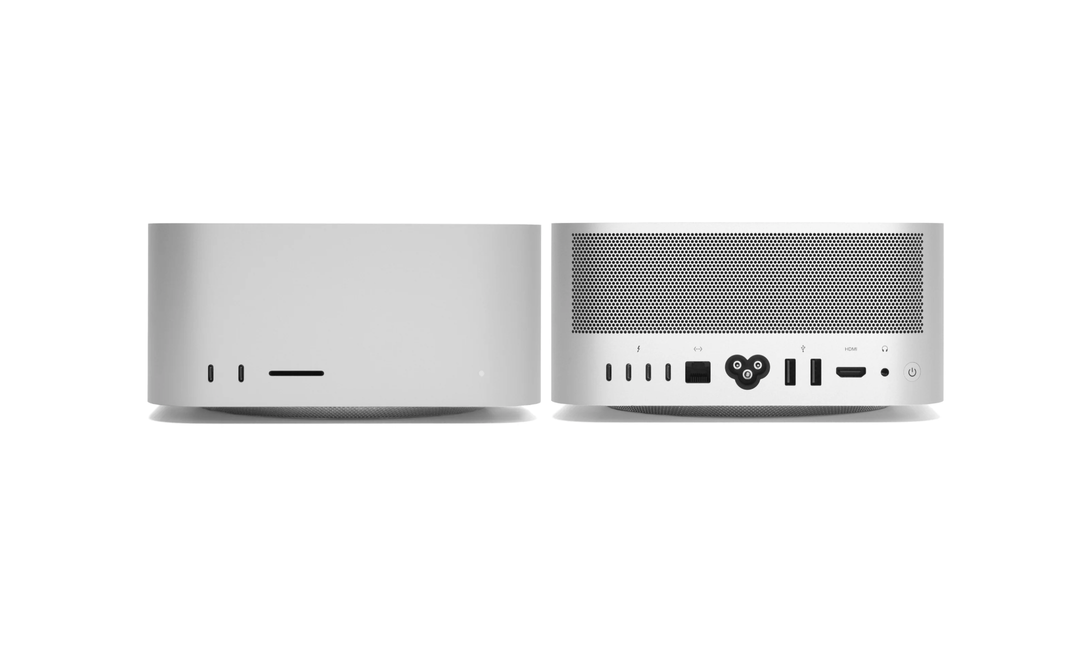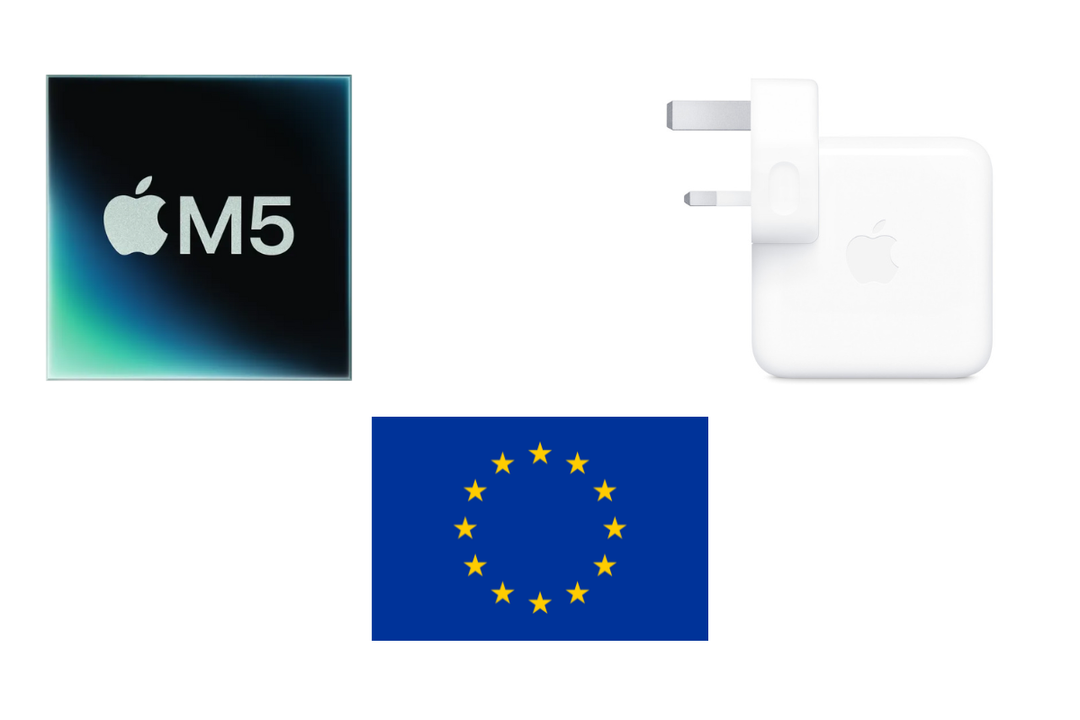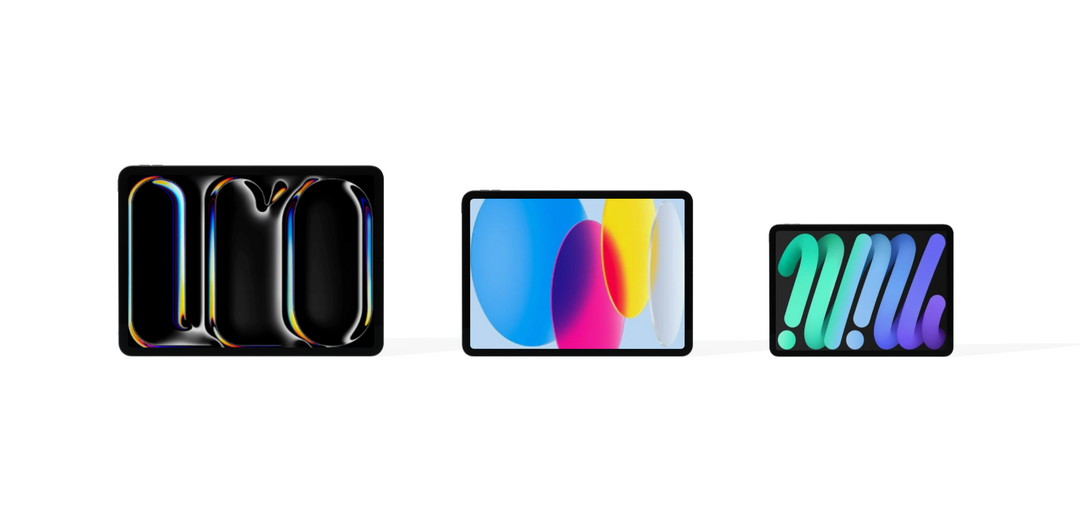If you're a creative professional, or simply someone who demands top-tier performance in a compact package, the Mac Studio is likely on your radar. First introduced in 2022, the Mac Studio bridges the gap between the Mac Mini and Mac Pro. It delivers workstation-class performance in a compact enclosure, built for professionals who need serious power without the bulk.
In this guide, we’ll cover everything you need to know about buying a Mac Studio: how to choose the right model, which features to prioritise, and why it's a smart investment.
Processor
The processor of your Mac is responsible for how quickly and efficiently it handles tasks. Since the Mac Studio's debut in 2022, Apple has released six different processors across four generations, which can make it tricky to understand which one is right for you.
It started with the M1 Max and M1 Ultra, followed by the M2 Max and M2 Ultra, and more recently, the M3 Ultra and M4 Max. The most important distinction lies between the Max and Ultra chips, as each is designed for different performance needs.
-
Max chips deliver an excellent balance of power and efficiency, ideal for most creative professionals, developers, and advanced users.
-
Ultra chips are engineered for extreme performance, especially in multi-core tasks such as high-resolution video editing, 3D rendering, and machine learning workloads.
Here’s a quick overview of the CPU core counts across the Mac Studio chip range:
-
M1 Max: 10-core CPU
-
M1 Ultra: 20-core CPU
-
M2 Max: 12-core CPU
-
M2 Ultra: 24-core CPU
-
M3 Ultra: 28-core or 32-core CPU
-
M4 Max: 14-core or 16-core CPU
Processor benchmarks
Geekbench scores provide a useful way to compare processor performance across different Mac Studio models. These benchmarks give a visual and numerical reference to help you see how each chip stacks up, the higher the score the better the device performs CPU related tasks.
Geekbench Multi-Core scores for all Apple Mac Studio processors, sorted from highest to lowest.
Insights from Geekbench Mulicore results
-
Performance Gains: Incremental, Not Transformational:
When evaluating chip performance, it's most accurate to compare processors within the same tier, Max vs. Max and Ultra vs. Ultra. Each new generation does bring performance improvements, but in many cases, the gains are incremental rather than dramatic. Unless you're a high-end user running complex, resource-intensive workflows, the jump between generations may not be significant enough to justify the additional cost.
-
Prioritise Workflow Over Benchmarks:
While Geekbench scores offer a helpful snapshot of raw processing power, they don’t tell the full story. Your actual workflow should be the primary factor in choosing the right chip.
-
If you regularly handle demanding tasks such as 3D rendering, high-resolution video editing, or large-scale simulations, then investing in a higher-tier Ultra chip may be well worth it.
-
On the other hand, for users focused on content creation, software development, or general productivity, a Max chip—even from a previous generation—can deliver more than enough power without overspending on performance you might never fully utilise.
-
In short, benchmark scores are helpful, but understanding how you use your machine day-to-day will lead to a better, more cost-effective decision.
Memory
Memory plays a key role in how smoothly your Mac Studio handles multitasking and large, complex projects. Thanks to Apple Silicon’s Unified Memory Architecture, the CPU and GPU share the same high-bandwidth memory pool offering faster performance and improved efficiency. But the big question remains: how much memory do you actually need?
Choose wisely - Memory can't be upgraded
One key thing to know: Mac Studio memory is not user-upgradable. The amount you choose at checkout is what you’re locked into, so it’s important to plan for both your current needs and potential future demands.
If you’re unsure how much memory you need:
-
Opt for the highest configuration your budget allows. It offers better longevity and performance headroom.
-
Check your current memory usage in Activity Monitor. If you're often using most or all of your available memory, an upgrade is likely worthwhile.
When to Consider more memory
Even if you're not monitoring memory metrics, your Mac will give you signs that it's running low on available RAM. Common indicators include:
-
Lag or delays when switching between multiple applications
-
Slower performance when working with large files (e.g., in Photoshop or Final Cut Pro)
-
Frequent app crashes or macOS memory warnings
-
General system sluggishness
If you notice any of these symptoms, it may be time to consider a higher memory option when configuring your next Mac Studio.
Mac Studio Memory options
| Model | Available Memory Options |
| 32GB or 64GB | |
| 64GB or 128GB | |
| 32GB, 64GB or 96GB | |
| 64GB, 128GBor 192GB | |
| Mac Studio M3 Ultra | 96GB, 256GB or 512GB |
| Mac Studio M4 Max | 36GB, 48GB, 64GB or 128GB |
Storage
Storage capacity determines how much data you can keep on your Mac Studio’s internal drive—everything from applications and system files to photo libraries, video projects, and creative assets. While it might seem like a straightforward choice, it’s easy to underestimate your long-term needs.
Assess before you invest
Before deciding on a configuration, it’s worth checking your current storage usage:
Go to: Apple Menu → About This Mac → Storage
This will show you how much space you're using and how it's being allocated across different types of files (apps, documents, media, etc.).
If you regularly work with large files such as 4K video, RAW images, 3D models, sound libraries or simply want to avoid the hassle of managing external drives, it makes sense to invest in a larger internal SSD.
Which storage size is right for you?
To help guide your decision, here’s a breakdown of who each storage tier is best suited for:
-
512GB – Ideal for light users, students, or those who primarily rely on cloud storage
-
1TB – A balanced option for most creative professionals who may use cloud storage or external drives.
-
2TB+ – Best for video editors, photographers, musicians and power users working with large multimedia libraries or project files
MacBook Pro Storage Options
| Model | Available Storage Options |
| Mac Studio M4 Max | 512GB, 1TB, 2TB, 4TB or 8TB |
| 1TB, 2TB, 4TB or 8TB | |
| Mac Studio M3 Ultra | 1TB, 2TB, 4TB, 8TB or 16TB |
GPU (Graphics processing unit)
The GPU (Graphics Processing Unit) is a key part of your Mac Studio’s performance—especially if you work with video editing, animation, 3D rendering or CAD. Apple offers a wide range of GPU configurations across its Max and Ultra chips, and your choice should depend on how graphics-intensive your workflow is.
GPU Benchmarks: What the numbers say
We’ve benchmarked all the Mac Studio GPU configurations using Geekbench Metal, which simulates real-world performance by replicating tasks fround in software like Final Cut Pro, DaVinci Resolve, Blender, and Adobe After Effects. Here's how they stack up:
Geekbench Metal benchmark scores for the GPU performance of all Apple Mac Studio, sorted from highest to lowest.
Choosing the Right GPU for Your Workflow
When selecting a Mac Studio, the right GPU depends on the kind of work you do. While benchmark scores show the raw power of each chip, real value comes from choosing a configuration that aligns with your actual needs.
-
If your work involves high-end 3D rendering, 8K video editing or visual effects you'll benefit most from the Ultra-tier GPUs.
-
For users focused on music production, design and productivity earlier Max chips (such as the M1 Max or M2 Max) still deliver smooth performance without overpaying for unused GPU headroom.
Ultimately, the best GPU is the one that supports your workflow without unnecessary expense. Use benchmarks as a guide—but let your daily tasks determine what you really need.
Ports and Connectivity
When it comes to ports and connectivity, the Mac Studio stands out from the rest of the Mac lineup. One of its biggest advantages is the extensive selection of ports, making it an ideal choice for professionals who rely on multiple peripherals in their workflow.
Whether you're working in a music studio, design environment, or video production setup, the Mac Studio is built to accommodate a wide range of equipment, external drives, cameras, audio interfaces, monitors, and more, all connected simultaneously without the need for extra hubs or adapters.
Each Mac Studio model offers a generous and thoughtfully designed port layout, including front-facing ports for easy access, perfect for desk setups where reaching around the back of the device isn't practical.
Left, Mac Studio front. Right, Mac Studio rear
Mac Studio Port Configurations
Below, you'll find a table that outlines the port configurations across the different Mac Studio models to help you compare at a glance.
| Model | Ports and Connectivity |
| Rear: Four Thunderbolt 4 ports (up to 40Gb/s), Two USB-A ports (up to 5Gb/s), HDMI Port, 10Gb Ethernet, 3.5mm headphone jack | |
| Rear: Four Thunderbolt 4 ports (up to 40Gb/s), Two USB-A ports (up to 5Gb/s), HDMI Port, 10Gb Ethernet, 3.5mm headphone jack | |
| Mac Studio M3 Ultra | Rear: Four Thunderbolt 5 ports (up to 120Gb/s), Two USB-A ports (up to 5Gb/s), HDMI Port, 10Gb Ethernet, 3.5mm headphone jack |
| Mac Studio M4 Max | Rear: Four Thunderbolt 5 ports (up to 120Gb/s), Two USB-A ports (up to 5Gb/s), HDMI Port, 10Gb Ethernet, 3.5mm headphone jack |
If you're unsure about the differences between Thunderbolt 4 and Thunderbolt 5, check out our detailed guide here.
External Display Support
One of the standout advantages of the Mac Studio is its exceptional support for multiple external displays. In this area, it outperforms most other Macs, only the Mac Pro offers similar capability, but at a significantly higher cost.
Whether you’re building a multi-monitor workstation for video editing, design, coding, or trading, the Mac Studio is engineered with productivity in mind.
Here’s a breakdown of how many external displays each model supports.
| Chip | External Display Support |
| Mac Studio M1 Max Mac Studio M1 Ultra | Up to 5 displays (4 with 6K resolution at 60Hz via USB-C, 1 with 4k resolution via HDMI) |
| Mac Studio M2 Max | Up to 5 displays (4 with 6K resolution at 60Hz via Thunderbolt, 1 with 4K resolution at 60Hz via HDMI) |
| Mac Studio M2 Ultra | Up to 8 displays (4k resolution at 60Hz) |
| Mac Studio M3 Ultra | Up to 8 displays (6K resolution at 60Hz or 4K resolution at up to 144HZ) |
| M3 Pro, M4 and M4 Pro | 2x 6K @ 60Hz (Thunderbolt), or 6K + 4K @ 144Hz (HDMI), or 1x 8K @ 60Hz / 4K @ 240Hz (HDMI) |
| Mac Studio M4 Max | Up to 5 displays (4 with 6K resolution at 60Hz via Thunderbolt, 1 with 4K resolution at 144Hz over HDMI) |
Size
The Mac Studio offers high performance in a form factor similar to the M1/M2 Mac Mini, but taller. It measures:
-
19.7cm x 19.7cm x 9.5cm
Its compact design, especially compared to a Mac Pro, makes it an excellent fit for a desk or studio rack, offering a clean and minimal setup.
Left: Mac Studio Right: Mac Pro
Consider Refurbished When Buying a Mac Studio
Now that you’ve narrowed down the specs and performance you need in a Mac Studio, it’s worth considering a refurbished model as a smart alternative to buying brand new.
Unlike privately sold second-hand devices, refurbished Mac Studios go through a professional restoration process to ensure they perform like new. At Hoxton Macs, every Mac Studio is carefully cleaned, thoroughly tested, and any faulty components are replaced. Our rigorous quality checks ensure each machine meets high standards for reliability and performance.
WHY CHOOSE A REFURBISHED MAC STUDIO?
Save Money
Enjoy the power of a Mac Studio at a significantly lower cost than buying new without compromising on quality.
Buy With Confidence
Skip the risks of private sales. Our refurbishment process ensures you’re getting a professionally restored, fully functional device.
1-Year Hardware Warranty
Every refurbished Mac Studio includes a 1-year hardware warranty for added peace of mind.
HAVE QUESTIONS?
We’re happy to help you choose the right Mac Studio for your needs or answer any questions about our refurbishment process.
Phone: 020 8819 3244
Email: info@hoxtonmacs.co.uk



